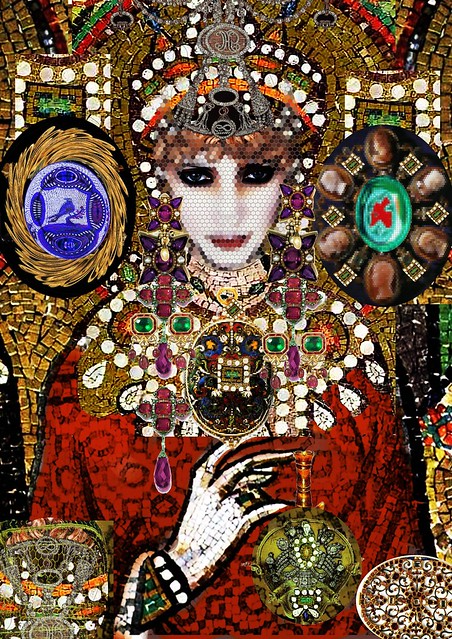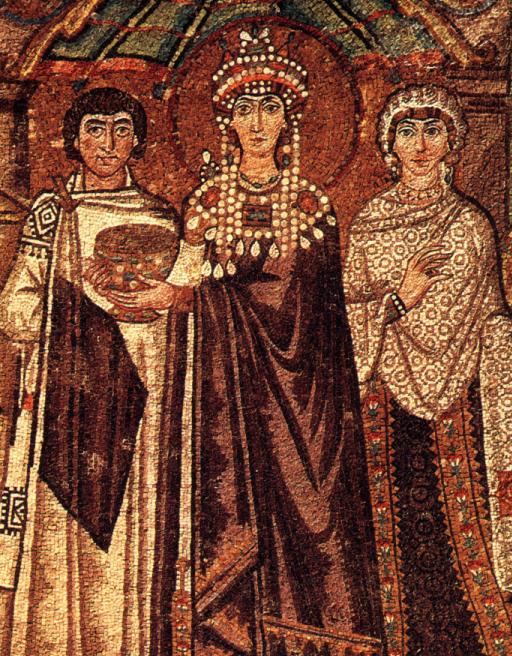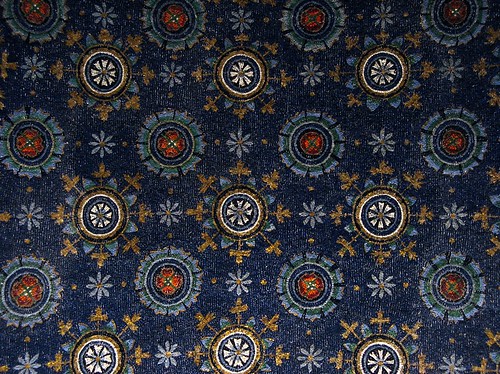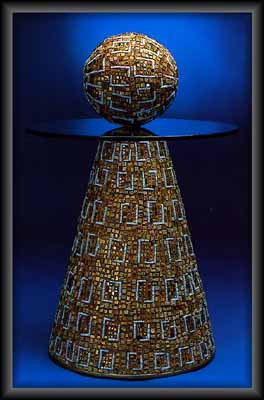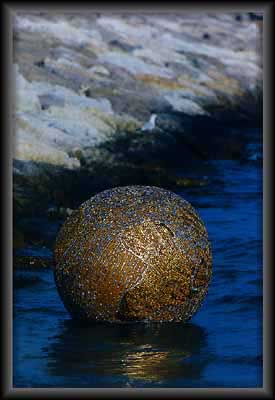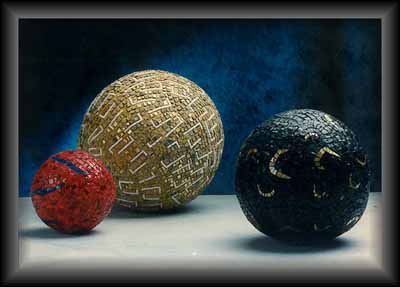This post started with the title "my favourite mosaics" but along the way it turned out to be generic because I kept mentioning things about the past and how we actually got to Byzantine mosaics (which are my favourite.) I want to highlight that, not being an art historian, a scholar or someone who has read a lot on the subject, what I write may not be perfect. It's all out of my unquenchable passion for mosaics. Naturally, I have done my best to provide reliable information and I give links for further reading. What's more, it's an itinerary that ends with Byzantine mosaics with no reference to the renaissance or modern times. It would take too much time to do everything in one post.
The oldest documented mosaics in world history are the ones found in Uruk, Mesopotamia, the so-called cone mosaics.
Here's a picture.
However, mosaic art in its own right is considered to have begun setting its roots from circa 400-500 BC so I have divided "history class" in four periods starting with Hellenistic mosaics then Roman, Early Christian and 11th-12th century Byzantine mosaics. These are the key periods in mosaic making due to the remarkable masterpieces that have come down to us. Mosaics continued to be made after the Fall of Constantinople in 1453 but it was only until recently that mosaic art regained its deserved position in the arts spectrum. Owing to artists like Antonio Gaudi, Gino Severini, Yiannis Kolefas to name those that come to mind.
Hellenistic period
Though Hellenistic mosaics is almost synonymous to Pella, I want to start with pictures of the "second best" mosaic sites in Greece. I have visited both and I recall the trip by boat to Delos where "only mosaics breath and live" as the island is deprived of inhabitants.
This next one is from Olynthos showing Bellerophon, riding Pegasus, slaying the Chimaira. Mosaic floor 432-348 BC.
Here's an interesting statement from Cardiff University:
"Tessellated mosaic is a Hellenistic invention. This paper looks at the development of mosaics in the Hellenistic period, starting with the spectacular pebble mosaics at Pella, probably financed with the spoils of Alexander's conquests, which are the first manifestations of a fundamental shift in attitudes that made private ostentation increasingly desirable..."
Here's another interesting statement from a book I googled:
"In mosaic, as in other arts, Italy in the last two centuries BC absorbed the full impact of Hellenistic influence".
The book is by Catherine M.D.Dunbabin and her book is called "Mosaics of the Greek and Roman world". A discussion about Hellenistic art should include a mention Sosos of Pergamon and his famous "unswept floor" (asaroton) invention. I call it invention because he was ..let's say in modern terms, a trendsetter, he created this specific style of mosaic making which you will see from the picture. A floor on which remnants of food are depicted with extreme detail. The Greek term "asaroton" brings to mind what the Greek Cypriots say still today when they sweep the floor, a completely ancient Greek word: "σαρίζω" (sarizo=I sweep). Sosos is also considered to be the artist of the original "dove basin" of which a later copy is at the Capitoline museum.
|
|
Detail of the "unswept floor"
|
Here's an excerpt from wikipedia: The Hellenistic period is equally the time of development of the mosaic, particularly with the works of Sosos of Pergamon, active in the 2nd century BC and the only mosaic artist cited by Pliny (XXXVI, 184). His taste for trompe l'oeil (optical illusion) and the effects of the medium are found in several works attributed to him such as the "Unswept Floor" in the Vatican museum, representing the leftovers of a repast (fish bones, bones, empty shells, etc.) and the "Dove Basin" at the Capitoline Museum, known by means of a reproduction discovered in Hadrian's Villa. In it one sees four doves perched on the edge of a basin filled with water. One of them is watering herself while the others seem to be resting, which creates effects of reflections and shadow perfectly studied by the artist. Here's an enlightening Britannica.com entry on Sosos: "Pergamum, another centre of the Hellenistic world, was particularly famous for its school of mosaics. According to the ancient Roman historian Pliny the Younger, Sosos, one of the most renowned mosaic artists of antiquity, worked in this city. None of his works survives but, thanks to Roman copies, the intentions that underlay his art can be judged. Pliny listed as his most celebrated works a..." (afraid the entry stops there)
We can' t talk about Hellenistic mosaics without mentioning Pella dating 4th century BC. Needs no introduction. I will only say that it's obvious that these superb pebble mosaics have provided the foundations for the evolution of mosaic art.
|
|
Pella pebble mosaic, Greece
|
Remarkable Greek mosaics were also found in the town of Eretria in Greece. Here's a peek.
sources:
By visiting the first link you will come across a page in Greek but the website is also available in English.
Another mosaic from Pella showing God Dionysos on a panther 4th century BC:
|
|
Pella mosaic featuring Dionysos
|
Roman period
When I think of what are the mosaic centerpieces in Pompeii, I travel with my mind a decade or more back and recall my trip there. I remember vividly the "pink" mosaic fountain.
Then I remember when I first laid my eyes upon Alexander the Great mosaic which has a little bit of interesting history in the sense that the mosaic, which embellished the floor of a Pompeian house, is deemed to be a copy of image by Apelles or Philoxenos of Eretria. The Alexander the Great mosaic must be one of the most famous pre-Christian mosaics worldwide (at the Naples Archeological museum - been there too; the only place I visited in Naples actually as time was limited and I was there for the mosaics and Pompeii...)
|
|
Alexander the Great mosaic from Pompei now at the Arch.Museum in Naples, Italy
|
Exquisite mosaics of the Roman era can also be seen in Cyprus. What's fascinating is the "local" character of the mosaics (I suppose as in other parts of the Roman world: we have Roman mosaics in "unbelievable" places such as Bulgaria and England and in those places too you feel an intrinsic echo of the place where the mosaic was made). Their style reflects the people, the climate, the temperamento and local art. I may write about this in more detail in a different post. I hope to. It's not a promise (sorry). Now, let's take a gander on these magnificent floor mosaics in Palea Paphos, Cyprus.
This next mosaic is in almost perfect condition showing Ikarios and the first wine drinkers (οι πρώτοι οινοπιόντες).
This next Cypriot mosaic is at the Archaeological museum in Nicosia. Playfully exquisite! It comes from the Kouklia area in Cyprus and it's dated 3rd century AD (for obvious reasons the mosaic could not go under Early Christian though it is 3rd century AD and not BC; I checked this twice. In Palea Pafos (Kouklia site) the cult of Aphrodite survived until 4th century AD when emperor Theodosios outlawed Paganism.
more here:
|
|
Leda and the Swan, Paphos
|
Definitely worthy of mention are the spectacular mosaics of Villa Romana del Casale which was a Roman villa built in the first quarter of the 4th century and located about 5 km outside the town of Piazza Armerina, Sicily.
The following 3 mosaics of Piazza Armerina are from http://www.galenfrysinger.com.
It's wonderful to be able to see the entire setting where mosaics were laid especially after their restoration. Here's a peek from the archeological site of Piazza Armerina:
Early Christian mosaics
The mosaics in Kourion have not been chosen by chance. Though completely "Roman" as far as style (Greek patterns, images-emblems and inscriptions), materials (stone, marble) and application (on floor) is concerned, they introduce us to the Christian era. The subjects are birds, fish and a goose. No more mythological scenes. The inscription (think of the inscriptions that always accompany the Byzantine mosaics and Byzantine icons in general) reflects the beliefs of the "new religion". It reads: " IN PLACE OF BIG STONES AND SOLID IRON, GLEANING BRONZE AND EVEN ADAMANT, THIS HOUSE IS GIRT WITH THE MUCH-VENERATED SIGNS OF CHRIST ". The original Greek text: "ΑΝΤΙ ΛΙΘΩΝ ΜΕΓΑΛΩΝ, ΑΝΤΙ ΣΤΕΡΕΟΙΟ ΣΙΔΗΡΟΥ ΧΑΛΚΟΥ ΤΕ ΞΑΝΘΟΙΟ ΚΑΙ ΑΥΤΟΥ ΑΝΤ ΑΔΑΜΑΝΤΟΣ (Ο)ΙΔΕ ΔΟΜΟΙ ΖΩΣΑΝΤΟ ΠΟΛΥΛΛΙΤΑ ΣΗΜΑΤΑ ΧΡΙΣΤΟΥ ". The mosaics at Eustolios complex in Kourion, Cyprus date 5th century AD.
A detail from the above mosaic:
This next picture is a detail from a larger mosaic. It shows a seashell, detail from a representation of the sea full of fish. It's from Daphne, a suburb of Antioch-on-the-Orontes (now Antakya in Turkey) dated 2nd half of the 3rd century AD.
The picture of the entire mosaic follows.
 |
| Antioch-on-the-Orontes |
The mosaics from Kanakaria (Kanakaria is the name of the church: Panagia tis Kanakarias, Greek: Παναγία της Κανακαριάς) are on top of my favourite mosaics list. Their beauty is striking, captivating, magnetising with the most simple of colours and without heavy details and lines (to be seen later in 11th - 12th century Byzantine mosaics).
This following article about Kanakaria mosaics and their "trials and tribulations" after the 1974 war in Cyprus, written in Greek and English is interesting and well written.
Here's an example from Kanakaria. Look at Matthew the Evangelist's humble yet penetrating and intense gaze.
A beautiful and interesting mosaic from Milan follows now from Cappella di San Vittore in ciel d'oro (situated inside Saint Ambrose basilica.) It shows Saint Victor. I like the “minimalist lavishness" of the gold background that highlights the centre figure producing a sublime effect without excessive decorative accompaniment. What's more appropriate than a gold surrounding to symbolise the virtues of a martyr? Must I say how much I like the red flowers on the circle border surrounding the Saint? A great mosaic of the 4th century.
The best place in Greece rich with various mosaic masterpieces to feast your eyes upon and feel as if you are not touching ground is Salonica (Thessaloniki, Θεσαλλονίκη.). An open museum. A similar case to that in Ravenna.
The above mosaic from Aghios Demetrios (St. Demetrios) church in Thessaloniki is dated 7th century. I love the colours, the expression, everything.The church exerts a strong emotional appeal to the people of Thessaloniki, while at the same time it constitutes a museum of Byzantine art. It was erected over the site of the Roman baths where the saint was martyred and where the earliest place of his worship once stood. A few more words about the mosaics of Aghios Demetrios basilica hoping that I won’t be too boring. The mosaics seem to attest the transition between Hellenistic and Byzantine Art. The principles of Hellenistic art have not been entirely abandoned. Yet something has changed. What's depicted, represented in the pictures is becoming gradually more flat and stylised. Of course with Christianity as the new religion, mosaic art finds its perfect "setting". Whereas it used to be an art that embellished the floors of the wealthy making them more beautiful and appealing, now it takes up a new role, a new mission, a new face. Mosaics are "lifted" literally and symbolically to a higher level. Before Christian times, mosaics were usually used on floors as I said earlier. Exceptions of wall mosaics are found in Pompeii.
Another interesting monument in Thessaloniki is Osios David, a tiny church up a hill (I remember going there and waiting for an hour or so until someone would come to open....). There you will find come across one of the rarest mosaics worldwide. An apse mosaic showing Christ without a beard.
Powerful, wonderful and spectacular are the mosaics in Ravenna dated 6th century. The lavishness of these mosaics achieved through strong colours, a distinct style as well as the application of mother- of-pearl make these mosaics outstanding.
|
|
Theodora mosaic, Ravenna, Italy
|
11th - 12th century mosaics
Mosaics of outstanding grandeur and sublimity are to be seen at Chora Monastery-Μονή της Χώρας (KIahriye Camii, Istanbul.) Constantinople boasts mosaic works of unparalleled magnificence and resplendence, of high importance both historical and religious, being a landmark for Christianity and the development of Byzantine art. I will focus on those mosaics that I personally like. One of them is the Virgin from the Chora Monastery. What impresses me most on this mosaic is the way the Virgin bends her head and her gaze both beautifully humble and contemplative.
|
|
Chora, Constantinople (today's Istanbul)
|
This is why religious mosaics are the hardest to make. Juxtaposing little stones aiming to represent emotion, humbleness, grandeur, spirituality. To find out more about Chora Monastery go to the following web space. It belongs to a photographer with amazing professional pictures.
The second mosaic from today's Istanbul is Empress Irini from Aghia Sofia (translated: Holy Wisdom). No need to make an introduction for Aghia Sofia or Hagia Sofia (Greek: Αγία Σοφία) by some considered the 8th wonder of the world and justifiably is a prototype for buildings of this category.
|
|
Aghia Sofia, Constantinople
|
I like mosaic "portraits". Notice the traits of the Empress, her face, her complexion colour and the lines providing evidence of how the Byzantines managed to balance natural characteristics and stylisation. It is known that Byzantine art is stylistic defying three dimensions in order to convey what's intangible and spiritual. Yet (and it's something that only a scholar can explain) these mosaics have something "real" and "natural" about them. This is what I have noticed mainly by observing the Constantinople mosaics. I may be entirely wrong or I may conceive things in a certain personal way but I am not writing for a PhD ..so .......let's just say this is what I "feel" when looking at the Empress Irini mosaic. I then think of Theodora mosaic in San Vitale, Ravenna, posted earlier, the wife of Justinian whose portrait has become a landmark for mosaics and for Ravenna. We are seeing two different mosaics with a nearly 500 year difference. The style is different, the colour treatment, the rendition of the face features. In the case of Theodora (and the Ravenna mosaics in general) the mosaic artists concentrate on colour and texture whereas in Constantinople I see the use of lines and well-defined face and body features, without defying colour or texture but ..How can I put this: the use of lines, colour and texture is balanced. I see perfection. I may try doing some comparisons later. It's challenging.
A superb mosaic that I have seen personally is in Torcello, Venice showing the Virgin with child in a gold background. 12th century.
This next mosaic is splendour at its best. One of the most captivating mosaics I have ever laid my eyes upon. I guess this is what angels look like (this one shows Archangel Gabriel.) Constantinople.
Further reading on Byzantine art.....for those who can't help it.
Byzantine art:
Psychology of Byzantine art:
(A must read for those who are touched by Byzantine art. I AM AFRAID IT'S ONLY IN GREEK. The original was in French. Paul Lemerle is the author).
Cyprus Byzantine painting and monuments:







